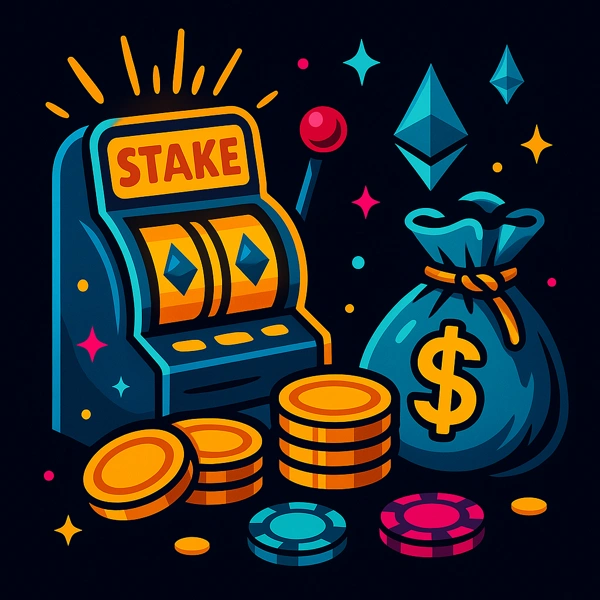Staking programs are one of the most hyped features in Web3 gambling. Instead of just playing games, you can stake tokens or stablecoins into casino vaults, prediction markets, or lottery pools and earn a share of the house edge, rake, or fees. It sounds like passive income — but staking in degen gambling dApps is high-reward, high-risk. Let’s break down how it works, who’s leading, and whether wagmi or ngmi.
Background & Why It Matters
Staking entered crypto gambling around 2019–2020, when platforms like BetFury and WINk started offering profit-sharing via their tokens. Since then, almost every major hybrid or Web3 casino has added a “be the house” staking model.
Why it matters:
- Players don’t just gamble — they invest in the casino.
- Creates loyalty and liquidity pools for the platform.
- Turns degens into partial owners of the house edge.
For casinos, staking = sticky liquidity. For players, it’s yield with gambling risk.
How Staking Works in Web3 Casinos
- Token Staking → Hold and lock native tokens ($BFG, $RLB, $WIN, $EUPH) to earn dividends or rakeback.
- Liquidity Vaults → Deposit USDT, ETH, or stablecoins into vaults that absorb wins/losses.
- Mining by Playing → Wagering mines new tokens (BetFury, WINk).
- Affiliate Boosts → Some staking pools increase referral commissions.
- Profit Share → A % of the house edge is paid to stakers daily/weekly.
Example: Rollbit’s RLB staking fuels jackpots. BetFury’s $BFG staking pays daily dividends.
Top Staking Programs to Know
🔹 BetFury ($BFG)
- Every wager mines $BFG.
- Stake $BFG to earn daily dividends in BTC, ETH, USDT.
- Millions paid to stakers since 2019.
- Risk: $BFG token volatility.
🔹 Rollbit ($RLB)
- Stake $RLB for jackpot participation + rewards.
- Token value tied to casino volume + hype.
- One of the most active degen staking loops.
🔹 WINk ($WIN)
- OG play-to-mine model on Tron.
- Stakers earned a % of casino profits.
- Token value collapsed, but model inspired others.
🔹 Euphoria ($EUPH)
- Multi-chain token staking.
- Rewards tied to casino fees.
- Still early, niche adoption.
🔹 On-Chain Vaults (Azuro, Parlay-style models)
- LPs deposit stablecoins.
- Earn house edge share + liquidity mining rewards.
- Pure “be the house” model without native tokens.
Safety & Risks
Pros
- Earn without active play.
- Alignment: house and players share upside.
- Long-term loyalty to platforms.
Cons
- Token price crashes can wipe rewards.
- Some casinos pay stakers in native tokens only.
- Smart contract risks in on-chain vaults.
- High withdrawal fees or lock-up penalties.
👉 Rule of thumb: casino staking = yield farming with extra degen risk.
What Players Say
- Fans → “best passive income in gambling, I’m literally the house.”
- Critics → “staking tokens is just exit liquidity for casinos.”
- On Telegram/Reddit, Rollbit and BetFury stakers flex payouts, but many ex-$WIN holders warn about token collapses.
Community vibe = hype + caution.
Who Uses Staking Programs
- Degens farming yield while playing.
- Whales stacking tokens for long-term rewards.
- Casuals who want passive drip.
- Not normies — too complex for non-crypto gamblers.
Real Stats
- BetFury has paid millions in daily dividends to $BFG stakers since 2019.
- Rollbit $RLB market cap (CoinGecko, 2025): $150M+, stakers earn jackpot exposure.
- WINk paid out big early, but $WIN token dropped over 90% since peak.
- On-chain vaults (Azuro, Parlay-style) often target 15–25% APR from house edge.
Numbers show: sustainable if volume stays high, wrecked if tokenomics collapse.
Degen Tip
If you stake, always claim rewards in stablecoins when possible. Don’t let all your gains ride on native tokens.
Final Degen Verdict
Staking programs in Web3 gambling are the bridge between DeFi and casinos. They’re exciting, profitable for early adopters, but incredibly risky long-term if token prices collapse or volume dries up.
For grinders and early degens, wagmi. For risk-averse investors, ngmi.
Staking proves one thing: in Web3 casinos, you can either be the gambler or the house — and sometimes both.


